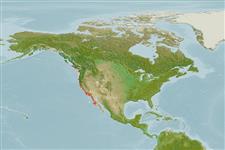>
Ovalentaria/misc (Various families in series Ovalentaria) >
Embiotocidae (Surfperches)
Etymology: Phanerodon: Greek, phaner, -eros = visible + Greek, odous = teeth (Ref. 45335); furcatus: furcatus meaning forked - referring to the tail (Ref. 6885).
More on author: Girard.
Environment: milieu / climate zone / depth range / distribution range
Ekologi
marina bottenlevande; djupintervall ? - 43 m (Ref. 2850). Subtropical; 52°N - 27°N, 130°W - 113°W
Eastern Pacific: Vancouver Island, southern British Columbia to Punta Cabras, northern Baja California, Mexico.
Size / Vikt / Age
Maturity: Lm ? range ? - ? cm
Max length : 32.0 cm TL hane/ej könsbestämd; (Ref. 2850)
Short description
Bestämningsnycklar | Morfologi | Morfometri
Taggstrålar i ryggfenan (totalt) : 9 - 11; Mjukstrålar i ryggfenan (totalt) : 20 - 26; Taggstrålar i analfenan: 3; Mjukstrålar i analfenan: 29 - 34; Ryggkotor: 38 - 42. Greenish above but predominately silvery; dark line at base of posterior part of dorsal; fins usually yellowish except for edging of dark on tail fin, and usually a dark spot on edge near anterior end of anal fin (Ref. 6885).
Adults often occur near piers, docks, in bays and sandy areas, but usually in quiet water and offshore areas near rocks (Ref. 2850). Viviparous, female carries the developing young (Ref. 205).
Life cycle and mating behavior
Maturities | Reproduktion | Spawnings | Egg(s) | Fecundities | Larver
Viviparous, female carries the developing young (Ref. 205).
Eschmeyer, W.N., E.S. Herald and H. Hammann, 1983. A field guide to Pacific coast fishes of North America. Boston (MA, USA): Houghton Mifflin Company. xii+336 p. (Ref. 2850)
IUCN Red List Status (Ref. 130435)
Threat to humans
Harmless
Human uses
Fiskeri: mindre kommeriell; sportfisk: ja
Verktyg
Warning: mysqli::__construct(): (HY000/1040): Too many connections in /var/www/html/includes/speciessummary.lib.php on line 2104
Can't connect to MySQL database fbquizv2. Errorcode: Too many connections
